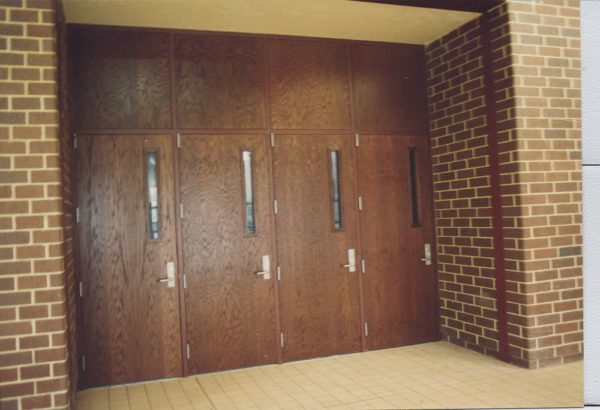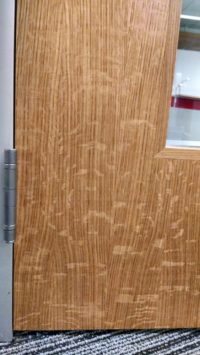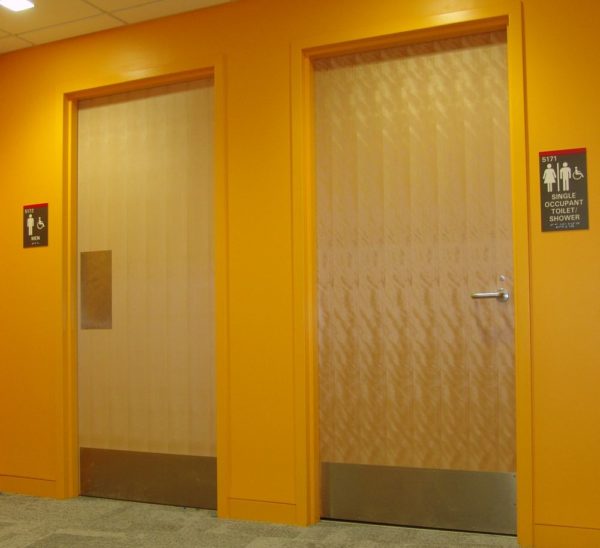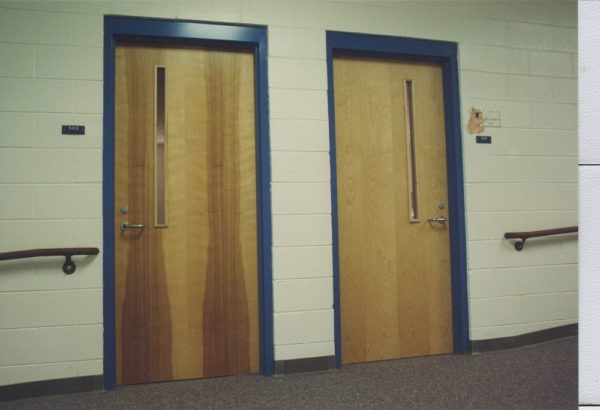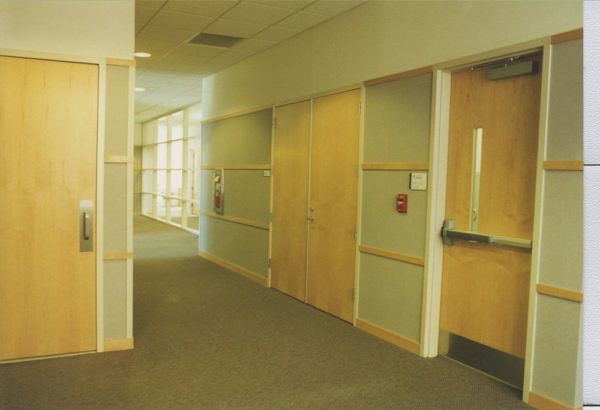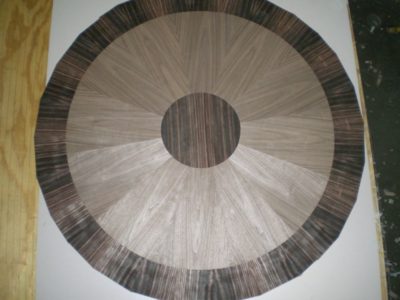Wood Veneer – Red Flags and Rules of Thumb
This article originally appeared in the June Issue of Door Security & Safety Magazine.
Beauty is in the eye of the beholder when it comes to wood veneer. Find out what to watch for during selection and specification.
By Bill Berryman, AWI, DHI, CSI
Why do wood doors and more particularly wood veneers seem to cause so much trouble?
As a wood door and veneer representative for more than 30 years, I am occasionally called to defend a product manufactured by my company on a jobsite. While my employers have certainly not been incapable of making mistakes, most of the time the concerns at the jobsite were attributed to choices or options from the specification that did not accurately convey design intent. The distributor, with little reason to question something he knew little about, followed the spec verbatim or made his own best interpretation.
I have compiled a Red Flags and Rules of Thumb list to keep on hand for spec interpretation, quote requests or to alert a specifier of a potential land mine. Remember, a landmine left because you had no time to diffuse it just might nick you too if left unheeded.
I compiled these lists for handouts when I conduct veneer training for groups. They are based on what I have determined carries the most weight or risk. The items below are by no means the complete list, but those who either specify or supply wood veneered doors or panels should find at least a few valuable nuggets to guide them through the minefield.
Basic Veneer Cut descriptors
Let’s begin with why, when it comes to wood veneer, beauty is in the eye of the beholder. Here are a few key descriptions.
- Rotary cut ($): wide, busy grain patterning and appearance. Typically relegated to lower cost architectural species like birch, white maple and red oak. This is often the least expensive cut in veneer slicing.
- Plain sliced/flat cut ($$): Prominent grain features are called “cathedrals.” Ascending, descending or both may be present, depending on the straightness of the individual log. This is the most common cut for hardwood veneers.
- Quarter sliced ($$$): Straight-grained appearance. The larger rays in oaks produce “flake/fleck” running at slight angles to the straight grain.
- Rift cut ($$$): The knife blade is adjusted 15 degrees from quarter slicing. Rift cut leaves show the straight-grained quartered appearance, without the flake.
Natural Characteristics
Natural characteristics are just that, not defects. Because wood is a product of nature, it often exhibits various characteristics common to many tree species, such as pin knots, cross bars and mineral streak. Other characteristics may be species-specific, like gum spots in cherry trees, worm tracks in ash or flake most often found in quartered oak.
Natural characteristics often intertwine with the twists and turns of natural growth, color and grain variation. These characteristics are the underpinning of why wood is so warm and appealing.
Industry Standards
The two most commonly specified industry standards for wood veneered panels and doors are the AWS (Architectural Woodwork Standards, Edition 2, 2014 – of the Architectural Woodwork Institute – AWI) and the WDMA (Window and Door Manufacturers Association, ANSI I.S. 1A – 13). These standards provide guidelines or rules. Veneer grade rules are included by permission from the Decorative Hardwoods Association (DHA), formerly the Hardwood Plywood and Veneer Association (HPVA).
If It Can Happen, It Will
Real wood is an example of Mother Nature’s finest artistic expression and sense of humor. Natural characteristics that seem amazingly cool to some, might be offensive or distracting to others. So, beware also of Mother Nature’s close associate Murphy (author of the Law of Coincidence), who ensures that the most objectionable natural characteristic shows up at the worst time and in the most conspicuous location. Some might believe more strongly in coincidence, but for those of us with more than a few jobsite visits under our belts, the overwhelming evidence supports the existence of both Mother Nature’s sense of humor as well as Murphy’s Law. Proactively addressing as many wood veneer trouble areas as one can, helps mitigate these risks going forward.
Veneer Cuts
“Rotary” cut in red oak veneer – the extremely wild, busy and rough grain patterning of this “Cut” in a coarse grain hardwood is often a specification oversight when the more orderly plain sliced was intended. Research and provide descriptions of the various cut appearances to clarify whether a different cut, such as plain sliced, would be preferred.
“Quarter” sliced in oak – many people like the straight grain appearance of quarter slicing in a variety of tree species. Many more are not aware that the flake is so striking in red and white quarter oak. The industry standards allow the unlimited presence of flake across all grades. Flake size and distribution can also vary.
Qualify that the characteristics of a quarter cut meet design intent. Specify “rift cut” for a straight grained look without the flake in red or white oak. If preferred, flake size may be further defined and specified as light, medium or heavy. Remember, any specification for quarter sliced “oak” allows unlimited flake.
Note – A specification that calls for “Quarter Sliced White Oak (plain, no figure) will disallow any “figure” from being present but will still allow unlimited “flake”. Standards do not consider flake and “figure” to be the same. Consider a “specified flitch” and involve your industry professional for best success with veneer specs, especially where natural characteristics might adversely affect the design intent.
Figuratively Speaking
“Figure” is a general term for nature’s many distinctive patterns, developed from natural deviations, of the normally straight grain in wood.
Figure is further defined by dozens of names for these distinctive patterns and can be specified by inclusion or exclusion as a part of the design intent. Figure (a characteristic not a defect) may be present in any species of wood or cut and is allowed across all grades. The frequency of figure is higher in certain species such as anigre, sapele, makore, eucalyptus, maple, walnut, and even birch. It is often priced higher and sorted for separate sale due to its greater value.
How is figure exposed during slicing?
Interlocked or irregular grain creates alternating dark and light patterning when the veneer knife slices through the log in a straight plane. This often produces fiddleback or curly figure, especially when quarter slicing. Softer looks, like quilted or pommele, are expressed more vividly by rotary cutting.
There can be red flags with figure because of its variations in size, density, and consistency across the veneer face. Note: you don’t have to specify figure to have it show up uninvited on your wood veneer, but you do have to specify it out if you do not want it.
Like flake in oak, people either like or dislike figure, and its presence, when unexpected, may be objectionable. For example, a simple specification stating, “shall be Quarter Sliced White Birch”, may often result in 40 to 60 percent of the faces exhibiting a distinctive wavy/curly figure. This is often a surprise to the design team when a plain, straight-grained appearance was expected. A sure bet, also, is that Murphy’s Law will place a non-figured door near/next to a figured door face when not addressed by the specification. Consult your Industry resources or design team to determine if there is, or should be, concern that figure will conflict with design intent.
To control the consistency, specifiers should establish a “range of figure” early on, for example from “light to medium”, if size or distribution is important to the design. If any figure present is undesirable, specify, for example, “shall be quarter sliced white birch (plain, no figure).”
Rare figures, like Birdseye maple, are further defined by light, medium or heavy density, and additionally as, small, medium and large regarding the size of the “eyes.” This attention to detail can make a great project stunning!
Color Choices in Natural Veneers
You must choose, so choose wisely. Natural species, such as birch, maple, ash, poplar and beech incorporate both heartwood and sapwood from within the same log, less the defects, and in any combination.
Typically, natural species display a distinctly lighter, outer sapwood, versus a darker, inner heartwood. No effort is made to control heartwood and sapwood percentages when natural veneers are supplied.
Note! If color consistency is desired, it cannot be achieved using natural species like birch. If color consistency is desired in a natural species, choose either select white birch (lighter sapwood only) or select red birch (darker heartwood only). The same is true with maple, ash, poplar and beech. Failure to choose, usually defaults to natural.
Why then are “Natural Species so commonly utilized? Natural veneers typically provide the lowest cost for that species relative to price between different cuts.
Note to Suppliers
While it is sometimes difficult to know an architect’s intent, in the absence of clear specification, a Request For Information (RFI) is always preferable to a potential confrontation.
Always clarify color choice when species such as birch, maple, ash, poplar or beech are specified, prior to supplying these veneers on wood doors or panels.
Always request or furnish veneer samples showing both heartwood and sapwood mixed together when natural species are specified/supplied.
Always include technical bulletins showing visuals that explain the nuances of natural veneers with your submittals. They may be downloaded from most major door and veneer manufacturer’s websites. That way your general contractor is also apprised of a potential controversy.
Communicate for Success
Be familiar with the industry standards. If your office doesn’t have a copy of the current AWS and WDMA, get them both. Study applicable sections prior to site visits. Phone calls instead of emails diffuse tense discussions. Follow-up emails capturing key points are smart business. You can use unanswered, unheeded RFI emails to demonstrate your intent to identify trouble areas. Engage your industry professional at an early stage.
Invariably, you will develop your own opinions and list of Red Flags and Rules of Thumb from your own experiences with what works or doesn’t work. Use them to proactively bring awareness to project conversations, preferably before a controversy occurs. Helping the project to go smoothly for others will have a reciprocal effect on you. It makes you the hero, the problem solver and often, the teacher.
Admittedly, advising others on available options for purchase or specification of wood veneers and wood doors can be a slippery slope, considering the vague and ambiguous choices available. Be the hero or enlist the services of the person who is.
Remember that beauty is in the eye of the beholder and that our collective integrity, no matter our position in the design, buy/supply chain stands on our effort to do everything possible to ferret out the details of potential problems. We must ask the necessary questions, identify trouble areas and most importantly, tap into the professional resources available to make the most informed decisions. Embracing this mantra, for the betterment of the project’s outcome, is called collaborative design. I implore you to consider this process, and the rest will fall more neatly into place,…for everyone.
Bill Berryman, AWI, DHI, CSI is VP Architectural Sales for Heitink Architectural Veneers and Plywood (Bloomington, IN), serving the A & D, Millwork, and General Contractor communities in the area of wood veneer selection and specification. He may be reached at bberryman@heitink.us.
More Resources on Wood Doors
The following resources were used in writing this article and provide further information on the topic.
AWI – Architectural Woodwork Standards – AWS 2nd Edition 2014. www.woodworkinginstitute.com.
WDMA – I.S. 1-A 2013 –The Window and Door Manufacturers Association, Interior Standard for Interior Architectural Wood Flush Doors. www.wdma.com.
“Identifying Wood – Accurate Results with Simple Tools,” Bruce Hoadley, The Taunton Press, 1990.
“Understanding Wood – A Craftsman’s Guide to Wood Technology,” Bruce Hoadley, The Taunton Press, 2000.
“Wood! Identifying and Using Hundreds of Woods Worldwide,” Eric Meier, 2016.
Jan Heitink, Heitink Architectural Veneers and Plywood, Bloomington, Indiana.


